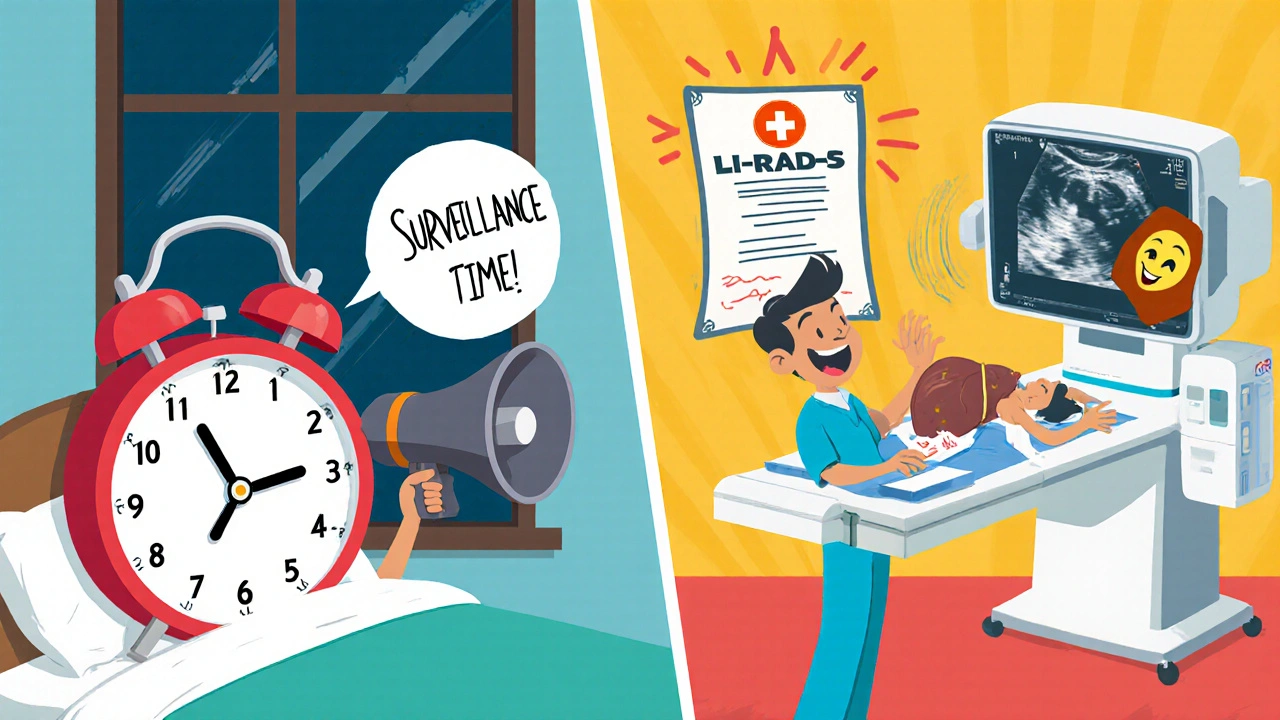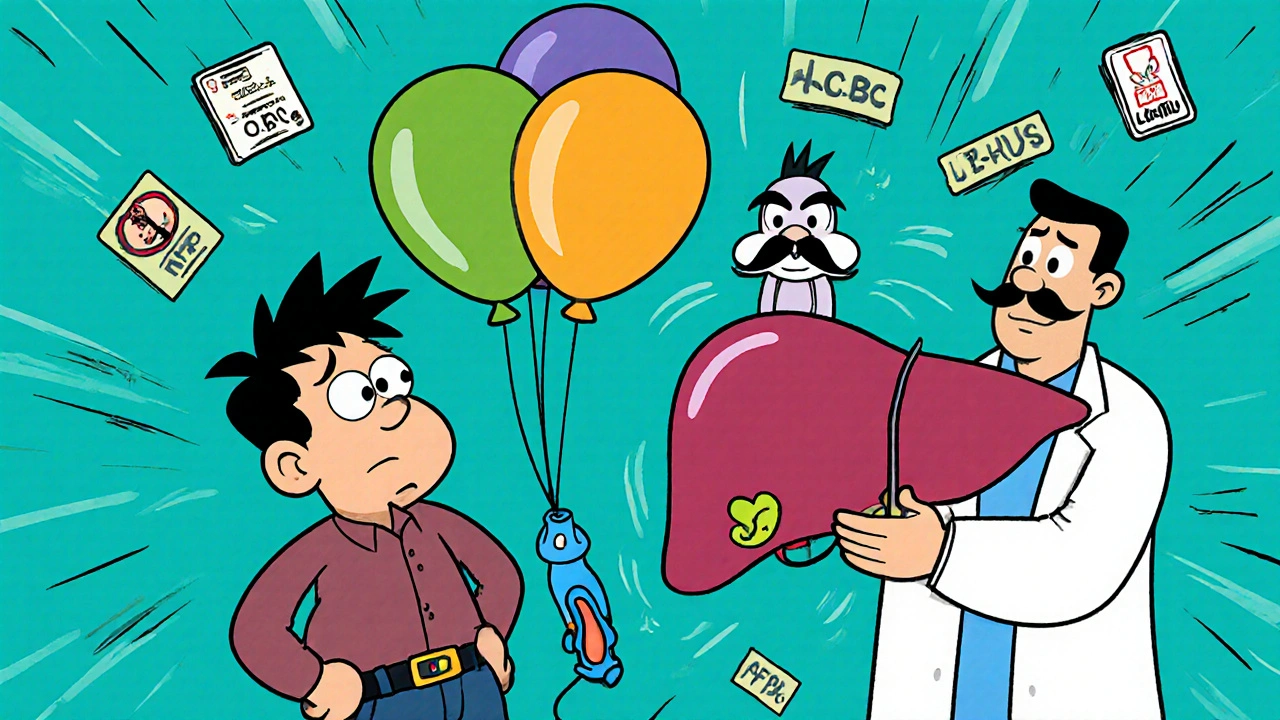Why Surveillance Matters for Cirrhosis Patients
Most people with cirrhosis don’t know they’re at high risk for liver cancer-until it’s too late. Hepatocellular carcinoma (HCC) develops in over 80% of cases in people who already have advanced liver scarring. Without regular checks, tumors grow silently, often reaching advanced stages before symptoms appear. By the time pain, bloating, or yellowing skin show up, the cancer is frequently no longer curable. But here’s the truth: if caught early, HCC can be treated successfully in more than half of cases. That’s why surveillance isn’t optional-it’s life-saving.
Studies show that patients who get regular screenings live longer. One major study found that people under surveillance had a 50-70% five-year survival rate, compared to just 10-20% for those never screened. That’s not a small difference-it’s the difference between dying within a year and living for years after diagnosis. The key? Catching tumors smaller than 2 cm, before they spread or damage the liver further.
Who Needs Surveillance and When
Not every person with liver disease needs screening. The guidelines are clear: if you have cirrhosis, you’re in the high-risk group. That includes cirrhosis from hepatitis B or C, alcohol use, non-alcoholic fatty liver disease (NAFLD), or autoimmune conditions. Even if you feel fine, even if your liver tests look normal, you still need screening. Cirrhosis changes the liver’s structure so much that cancer can grow without causing obvious signs.
But here’s where things get more nuanced. The European Association for the Study of the Liver (EASL) now recommends risk-based screening. That means not everyone with cirrhosis gets the same plan. Patients with an annual HCC risk above 1.5%-which covers most people with cirrhosis-are advised to get an ultrasound every six months. Those with lower risk (like someone with well-controlled NAFLD and no other complications) might not need it as often. Meanwhile, the American Association for the Study of Liver Diseases (AASLD) still recommends biannual screening for all cirrhotic patients, unless they’re in Child-Pugh Class C (severe liver failure) and not eligible for transplant.
Why the difference? Because screening isn’t free. It costs time, money, and sometimes causes unnecessary stress. If you’re not at high risk, you might be better off avoiding repeated scans. But if you have hepatitis B, heavy alcohol history, or high AFP levels, you’re in the danger zone-and you need to be checked every six months, no exceptions.
How Surveillance Works: Ultrasound and Blood Tests
The standard tool for HCC screening is abdominal ultrasound. It’s cheap, non-invasive, and widely available. A trained technician uses a probe on your abdomen to look for lumps, changes in liver texture, or abnormal blood flow. The goal? Find anything larger than 1 cm. That’s the size threshold that triggers deeper testing.
Many clinics also check a blood marker called alpha-fetoprotein (AFP). When AFP rises above 20 ng/mL, it’s a red flag. But here’s the catch: AFP isn’t perfect. About 30-40% of early HCC cases have normal AFP levels. That’s why ultrasound remains the backbone of screening. AFP is just a sidekick-not the main tool.
Some centers are starting to use newer blood tests like the GALAD score, which combines AFP with other proteins and patient details (age, gender) to improve accuracy. These are still mostly used in research or specialized clinics, but they’re showing promise. One study found GALAD detected 85% of early HCC cases with very few false alarms. In the next few years, these tests could become part of routine screening.

What Happens When Something Shows Up
If your ultrasound finds a lump bigger than 1 cm, or your AFP spikes, you don’t wait. You get a contrast-enhanced CT or MRI scan within weeks. These scans use dye to highlight blood flow patterns in the liver. HCC tumors have a unique signature: they take up dye quickly and then lose it fast. Radiologists use a system called LI-RADS to classify these findings. A LI-RADS 5 result means there’s a 95% chance it’s HCC-no biopsy needed.
Biopsies are rarely done anymore for typical HCC cases. Why? Because imaging is so accurate now. Taking a needle into a cirrhotic liver carries risks-bleeding, spreading cancer cells. If the scan looks like HCC and you have cirrhosis, the diagnosis is almost certain.
What if it’s not HCC? It could be a benign nodule, a regenerative lump, or even an infection. But you still need follow-up. Some nodules grow slowly. Others disappear. Either way, you’re monitored every 3-6 months until the picture clears.
Treatment Options: From Cure to Control
If HCC is caught early, you have real chances of beating it. The best outcomes come from treatments that remove or destroy the tumor without removing the whole liver.
- Resection: Surgery to cut out the tumor. Works best if the tumor is small, single, and your liver still functions well. Not an option for advanced cirrhosis.
- Transplant: Replacing the whole liver. This is the gold standard for patients with small HCC and severe cirrhosis. But there’s a shortage of donors, and you need to be on a waiting list for months or years.
- Ablation: Burning or freezing the tumor with a needle. Radiofrequency ablation (RFA) and microwave ablation are common. Done through the skin, no big incision. Works great for tumors under 3 cm.
- Embolization: Blocking blood flow to the tumor. TACE (transarterial chemoembolization) delivers chemo directly to the tumor while cutting off its supply. Used for larger tumors or when surgery isn’t possible.
For advanced cases where the cancer has spread beyond the liver, treatments shift from cure to control. Drugs like sorafenib, lenvatinib, or immunotherapy combinations (atezolizumab + bevacizumab) can slow growth and extend life by months-even years. These aren’t cures, but they give time. And time means more chances for new treatments to emerge.

Why So Many People Still Miss Screening
Even though guidelines are clear, only about 40% of cirrhotic patients in the U.S. get screened regularly. Why? It’s not because doctors don’t know. A study of 1,247 hepatologists found 92% knew the guidelines. But only 58% followed them consistently.
The biggest barriers? Electronic health records don’t remind providers. Primary care doctors don’t know when to refer. Patients miss appointments. One study found 25-40% of people skip their ultrasound. Some don’t understand the risk. Others are afraid of what they might find. Some can’t afford the time off work or the co-pay.
There’s also a racial gap. White patients are more likely to be screened than Black patients. Privately insured patients get screened more than those on Medicaid. These aren’t medical differences-they’re system failures.
Successful programs fix this. Hospitals that use patient navigators-people who call, remind, and escort patients to appointments-cut no-show rates in half. Clinics that embed screening into their electronic workflows see adherence jump from 35% to nearly 70%. It’s not about better medicine. It’s about better systems.
What’s Coming Next
The future of HCC screening is smarter, not just more frequent. The aMAP score-based on age, gender, albumin, bilirubin, and platelets-is already being tested to predict risk with 81% accuracy. That means you won’t just get screened because you have cirrhosis. You’ll get screened because your personal risk is high.
MRI is becoming more practical. New abbreviated protocols take only 5-7 minutes and cost under $400. They’re more sensitive than ultrasound, especially for small tumors. By 2027, high-risk patients may routinely get MRI instead of ultrasound.
AI tools are also entering the game. FDA-cleared software like LiverAssist helps radiologists spot tiny tumors that the human eye might miss. One study showed a 20% increase in detection rates. These aren’t replacing doctors-they’re helping them see better.
And soon, blood tests may take the lead. The HESBA alliance is testing 17 new biomarkers. If one proves reliable, we could one day screen with a single blood draw instead of an ultrasound. That would change everything-especially in rural areas or countries with limited imaging access.
What You Should Do Now
If you have cirrhosis, ask your doctor: "Am I on the HCC surveillance list? When was my last ultrasound?" Don’t wait for them to bring it up. Write it down. Set a calendar reminder. If your doctor says you don’t need it, ask why. Get a copy of your liver function tests and AFP levels. Know your risk.
If you’re a caregiver or family member, help with transportation, reminders, and questions. Many patients don’t speak up because they’re overwhelmed. Your support can make the difference between early detection and late-stage cancer.
And if you’re a provider-use your EHR. Set up alerts. Train your staff. Don’t assume someone else is handling it. Surveillance saves lives. But only if it happens.
How often should someone with cirrhosis get screened for liver cancer?
People with cirrhosis should get an abdominal ultrasound every six months. This is the standard recommendation from the AASLD and EASL. Some newer guidelines suggest risk-based screening, meaning high-risk patients (like those with hepatitis B or high AFP) get screened every 6 months, while lower-risk patients may be monitored less often. But for most, biannual ultrasound is the rule.
Can a blood test alone detect liver cancer?
No. The AFP blood test can raise suspicion, but it misses too many early cancers. About 40% of HCC cases have normal AFP levels. Ultrasound remains the primary screening tool because it can actually see tumors. Newer blood tests like GALAD are promising and may soon supplement imaging, but they’re not ready to replace it yet.
Is HCC screening covered by insurance?
Yes, in most cases. Medicare and most private insurers cover biannual ultrasound for patients with cirrhosis. The cost is typically under $300 per scan. Some plans may require prior authorization, especially if AFP testing is added. Always check with your provider, but screening is considered medically necessary and widely reimbursed.
What if I have cirrhosis but no symptoms? Do I still need screening?
Yes, absolutely. HCC often causes no symptoms until it’s advanced. Many people feel fine-even with severe cirrhosis-until the cancer grows large enough to cause pain, swelling, or jaundice. By then, treatment options are limited. Screening is designed to catch cancer before symptoms appear. If you have cirrhosis, you’re at risk, regardless of how you feel.
Can HCC be cured?
Yes-if caught early. For tumors smaller than 3 cm, treatments like surgery, ablation, or liver transplant can eliminate the cancer with high success. Five-year survival rates exceed 60% for early-stage HCC. But if the cancer has spread beyond the liver, cure is unlikely. Treatment then focuses on slowing growth and extending life. That’s why early detection through surveillance is so critical.





Joe Durham
November 20, 2025 AT 06:11Really appreciate this breakdown. I’ve seen too many patients delay screening because they ‘feel fine.’ The stats don’t lie-early detection flips the script from terminal to treatable. Even if it’s just a 6-month ultrasound, it’s the difference between burying someone and watching them graduate their kid from college.
Christopher K
November 20, 2025 AT 12:08Oh great, another ‘get screened’ PSA. Meanwhile, my cousin got diagnosed with HCC last year and spent $200k on ‘surveillance’ only to die 8 months later. Who’s paying for this nonsense? The system’s rigged to keep billing, not saving lives.
Michael Salmon
November 20, 2025 AT 17:38Let’s be real-this whole surveillance thing is a money grab. Ultrasounds every 6 months? That’s just a revenue stream for imaging centers. Most cirrhotics die from complications anyway. Why waste resources chasing tumors that are already baked into a failing liver? You’re not curing cirrhosis, you’re just delaying the inevitable with a $300 scan.
And don’t get me started on AFP. It’s like using a flashlight to find a needle in a hurricane. Half the time it’s normal when cancer’s there, and half the time it’s elevated because the patient drank coffee that morning. This isn’t medicine-it’s performative healthcare.
Meanwhile, the real problem? Nobody’s fixing the root cause. Alcohol, obesity, hepatitis-these are social problems, not medical ones. But hey, let’s keep scanning and billing while the opioid epidemic eats the rest of the country.
Christopher Robinson
November 21, 2025 AT 11:54Big thanks for laying this out so clearly 🙏 I work in a community clinic and we just started using patient navigators last year-no-show rates dropped from 40% to 15%. It’s not fancy tech, just someone calling and saying, ‘Hey, I’ve got your ride to the ultrasound at 2.’ Simple, human, works. 🚗💙
Derron Vanderpoel
November 21, 2025 AT 12:27OMG I JUST REALIZED MY DAD HAS CIRRHOSIS AND HASN’T HAD A SCAN IN 2 YEARS 😭 I’M CRYING RIGHT NOW I’M SO STUPID I THOUGHT IF HE FELT OKAY HE WAS FINE I’M CALLING HIM RIGHT NOW AND DRIVING HIM TO THE CLINIC TOMORROW I’M SO SCARED I’M SO SORRY I DIDN’T KNOW THIS WAS A THING 😭😭😭
Timothy Reed
November 23, 2025 AT 07:13One point worth emphasizing: while guidelines vary between AASLD and EASL, the consensus is clear-cirrhosis equals high risk. Risk stratification is useful, but it should never be used as an excuse to delay screening. A patient with well-controlled NAFLD may have lower risk, but they’re still at higher risk than someone without cirrhosis. When in doubt, screen.
Also, the shift toward MRI and AI-assisted diagnostics is promising. We’re moving from ‘see if something’s there’ to ‘predict where it’s likely to be.’ That’s not just progress-it’s precision.
Nick Lesieur
November 24, 2025 AT 10:23lol so the doc says ‘get screened’ but my insurance won’t cover it unless i have ‘complications’… which i don’t because i’m ‘fine’… until i’m not. classic. also my primary care doc has never heard of GALAD or LI-RADS. guess i’ll just wait till my belly swells up and my eyes turn yellow. 🤡
James Ó Nuanáin
November 25, 2025 AT 09:54It is, of course, profoundly regrettable that the United States continues to lag behind nations with universal healthcare in implementing consistent surveillance protocols. In the UK, all cirrhotic patients are enrolled in a national registry with automated recall systems. The absence of such infrastructure here is not a medical failure-it is a moral one. We are not merely neglecting patients; we are abandoning them to bureaucratic inertia.
And yet, one cannot help but observe that the American medical-industrial complex has turned surveillance into a revenue-generating apparatus, while simultaneously failing to address the socioeconomic determinants that lead to cirrhosis in the first place. The irony is not lost.
harenee hanapi
November 27, 2025 AT 08:47you all are so naive… i had a friend with cirrhosis and she got screened EVERY 6 months for 3 years and they kept saying ‘nothing’… then one day she just collapsed and died… turns out the tumor was hiding in the diaphragm and the ultrasound missed it… so what’s the point? you’re just giving people false hope… and making them spend money they don’t have… i’m not saying don’t screen… i’m saying don’t believe the hype… it’s all just… a game.